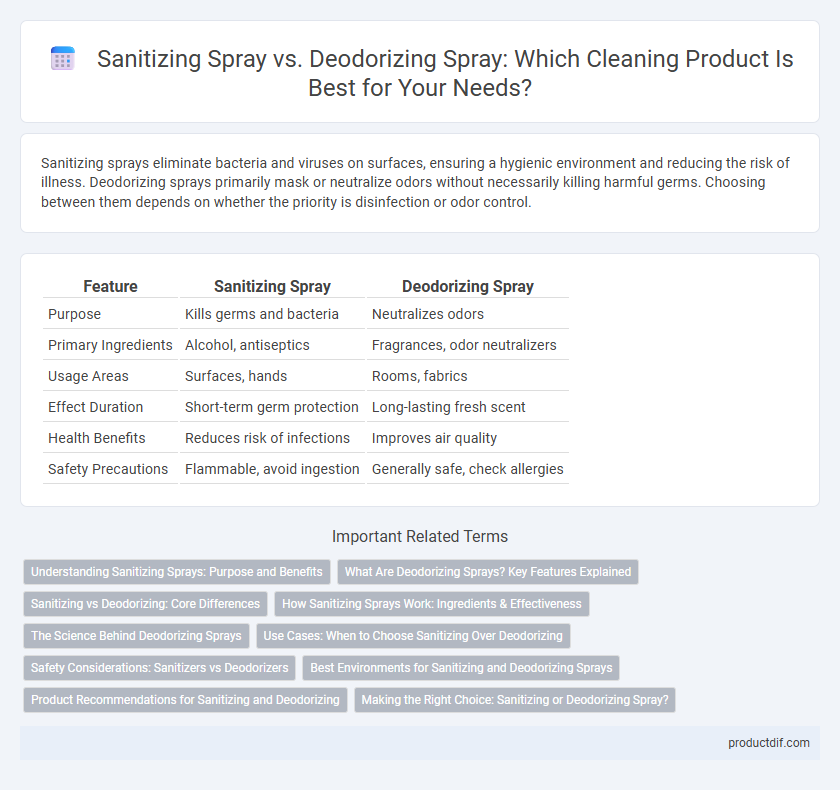Sanitizing sprays eliminate bacteria and viruses on surfaces, ensuring a hygienic environment and reducing the risk of illness. Deodorizing sprays primarily mask or neutralize odors without necessarily killing harmful germs. Choosing between them depends on whether the priority is disinfection or odor control.
Table of Comparison
| Feature | Sanitizing Spray | Deodorizing Spray |
|---|---|---|
| Purpose | Kills germs and bacteria | Neutralizes odors |
| Primary Ingredients | Alcohol, antiseptics | Fragrances, odor neutralizers |
| Usage Areas | Surfaces, hands | Rooms, fabrics |
| Effect Duration | Short-term germ protection | Long-lasting fresh scent |
| Health Benefits | Reduces risk of infections | Improves air quality |
| Safety Precautions | Flammable, avoid ingestion | Generally safe, check allergies |
Understanding Sanitizing Sprays: Purpose and Benefits
Sanitizing sprays are formulated to kill bacteria, viruses, and fungi on surfaces, effectively reducing microbial contamination and minimizing the risk of illness. They typically contain active ingredients such as alcohol, quaternary ammonium compounds, or chlorine-based agents that disrupt pathogen cell membranes. By targeting harmful microorganisms, sanitizing sprays provide a vital layer of protection in both residential and commercial environments, promoting healthier spaces.
What Are Deodorizing Sprays? Key Features Explained
Deodorizing sprays are cleaning products designed to eliminate unpleasant odors by neutralizing or masking them rather than killing germs or bacteria. Key features include fast-acting fragrance release, odor absorption technologies, and compatibility with various surfaces like fabrics and air spaces. Unlike sanitizing sprays, deodorizing sprays focus primarily on creating a fresh environment without providing antimicrobial protection.
Sanitizing vs Deodorizing: Core Differences
Sanitizing sprays contain active antimicrobial agents designed to kill or reduce bacteria, viruses, and fungi on surfaces, making them effective for health and hygiene purposes. Deodorizing sprays primarily mask or neutralize odors without eliminating harmful pathogens, focusing on improving sensory air quality rather than sanitation. Understanding the core difference between sanitizing and deodorizing sprays is essential for selecting the appropriate product for cleaning versus odor control in environments like kitchens, bathrooms, and public spaces.
How Sanitizing Sprays Work: Ingredients & Effectiveness
Sanitizing sprays contain active ingredients like alcohol, benzalkonium chloride, or hydrogen peroxide that target and kill bacteria, viruses, and fungi on surfaces by disrupting their cellular membranes or genetic material. These sprays typically achieve a 99.9% reduction in microbial presence within minutes, making them effective for reducing the risk of infections. The effectiveness depends on contact time, concentration of active agents, and proper application to ensure thorough surface coverage.
The Science Behind Deodorizing Sprays
Deodorizing sprays work by neutralizing odor-causing molecules using chemical agents such as cyclodextrins or masking fragrances, effectively reducing unpleasant smells without killing bacteria. These sprays target volatile organic compounds that contribute to odors, binding or altering them to prevent detection by the olfactory system. Unlike sanitizing sprays, which contain disinfectants like ethanol or quaternary ammonium compounds to eliminate microbes, deodorizing sprays focus primarily on odor control rather than microbial sanitation.
Use Cases: When to Choose Sanitizing Over Deodorizing
Sanitizing sprays are ideal for eliminating harmful bacteria and viruses on high-touch surfaces like doorknobs, countertops, and bathroom fixtures, providing a protective layer against illness. Deodorizing sprays primarily target unpleasant odors in spaces such as living rooms, kitchens, and pet areas, without necessarily killing germs. Choose sanitizing sprays in environments requiring infection control, such as healthcare settings or during cold and flu seasons, whereas deodorizing sprays are best for maintaining a fresh-smelling atmosphere.
Safety Considerations: Sanitizers vs Deodorizers
Sanitizing sprays contain active antimicrobial agents designed to kill bacteria and viruses, requiring careful handling to avoid skin irritation or respiratory issues. Deodorizing sprays primarily mask odors without eliminating pathogens, typically posing fewer health risks but may contain allergens or irritants. Both types demand proper ventilation during use and clear labeling to ensure safe application, especially in environments with children or sensitive individuals.
Best Environments for Sanitizing and Deodorizing Sprays
Sanitizing sprays are best used in environments requiring germ elimination such as kitchens, bathrooms, and healthcare settings, effectively reducing bacteria and viruses on surfaces. Deodorizing sprays excel in spaces with persistent odors like gyms, trash areas, and pet zones, neutralizing smells rather than killing germs. Choosing the right spray depends on the specific need for hygiene or odor control to maintain a clean and pleasant environment.
Product Recommendations for Sanitizing and Deodorizing
Sanitizing sprays with at least 70% alcohol content effectively kill germs on surfaces, making brands like Lysol Disinfectant Spray and Clorox Clean-Up ideal for disinfecting high-touch areas. For deodorizing purposes, products such as Febreze Fabric Refresher and OdoBan Odor Eliminator neutralize unpleasant odors without masking them, using specialized fragrances and enzyme-based formulas. Selecting sprays with EPA registration for sanitizing and non-toxic ingredients for deodorizing ensures safe and efficient use in homes or workplaces.
Making the Right Choice: Sanitizing or Deodorizing Spray?
Sanitizing sprays eliminate up to 99.9% of bacteria and viruses on surfaces, reducing the risk of illness and ensuring a hygienic environment. Deodorizing sprays mask or neutralize odors without killing germs, making them ideal for freshening rooms or fabrics without disinfecting. Choosing between sanitizing and deodorizing sprays depends on whether the priority is microbial safety or odor control, especially in high-touch areas versus casual living spaces.
Sanitizing spray vs Deodorizing spray Infographic

 productdif.com
productdif.com